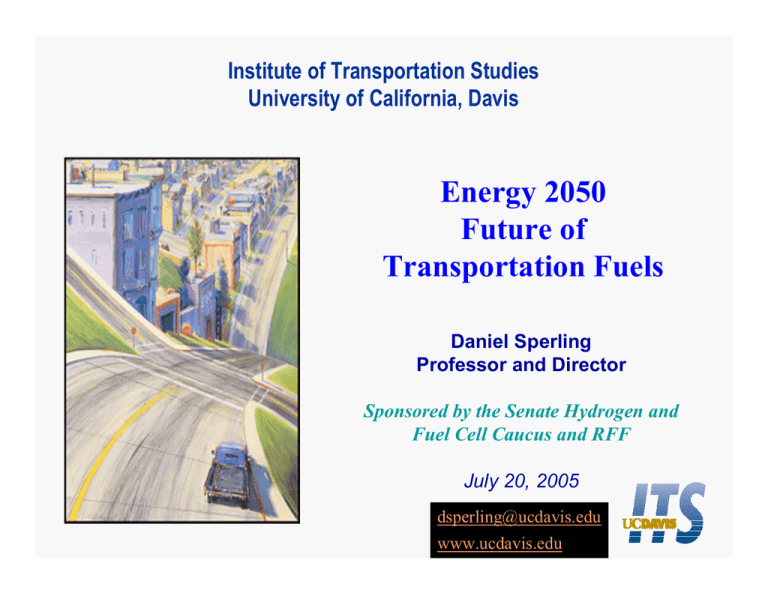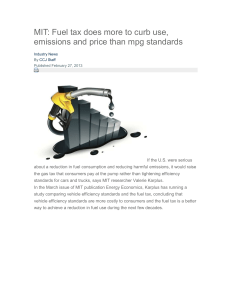Energy 2050 Future of Transportation Fuels Institute of Transportation Studies
advertisement

Institute of Transportation Studies University of California, Davis Energy 2050 Future of Transportation Fuels Daniel Sperling Professor and Director Sponsored by the Senate Hydrogen and Fuel Cell Caucus and RFF July 20, 2005 dsperling@ucdavis.edu www.ucdavis.edu “The era of easy oil is over.” David O’Reilly, Chevron CEO Yet Oil Consumption is Rising Rapidly Everywhere … Mostly due to increasing number of vehicles 125 million barrels per day 100 75 Other China U.S. FSU 50 W.Europe Japan 25 0 1960 1970 1980 1990 2000 2010 2020 2025 Oil Imports are Rising Rapidly in US 2/3 of oil is used for transportation Source: EIA (DOE) Good news: World fossil fuel supply is huge. Bad news: Unconventional oil and other fossil sources have large environmental and/or economic costs, and higher GHGs --and 2/3 of remaining conventional oil is in Middle East and cheap. But most conventional oil is in Middle East Source: H. H. Rogner, “An Assessment of World Hydrocarbon Resources,” Annual Review of Energy and Environment, 1997. Oil is being re-carbonized … heavy oil, tar sands, coal-to-liquids are carbon intensive Photo of Alberta Tar Sands Tar Sands Solving oil problem, but exacerbating GHG problem Production (mostly Alberta) (million b/d): 1990: 0.4 2003: 1.1 2012: 2.0 2030: 5.0 GHG emissions (tar sands vs petroleum): +37% (surface mining) +50% (in situ) Point #1: Trends Not “Sustainable” • More vehicles using more oil ¾ Transit share dropping (<2% in US) ¾ Vehicle ownership and use increasing (1.1 vehicles/driver) ¾ Vehicles getting larger and heavier • Oil imports increasing • Oil getting “re-carbonized” • GHG emissions increasing (+2%/yr in US) What Can Be Done to Reduce GHG Emissions and Energy Use? Reduce vehicle travel ¾ But highly unpopular (with voters and politicians) Improve conventional technology ¾ Many possibilities, including hybrids promising, but limited impact due to resistance to pricing/regulatory policy Introduce advanced vehicles and low-carbon fuels ¾ Interest in biofuels, H2, and fuel cells We need green technology! Vehicle Fuel Economy Dropping Past 18 Years Fuel Economy by Model Year 30 Average MPG Cars 25 Both Trucks 20 15 10 1970 1975 1980 1985 1990 1995 2000 Model Year Source: Heavenrich, R.M., and K.H. Hellman. 2000 But not for lack of innovation. Fuel economy ≠ fuel efficiency Efficiency innovations offset by increased weight, size, power Source: Hellman and Heavenrich, EPA 2003 If trends continue, this will be the SUV of the future … hybridized or with fuel cell! 4.5´ longer, 2´ higher than Hummer. For sale Sept 2004! Navistar ad says: “POSSIBLY TOO MUCH TRUCK . LIKE THAT’S A PROBLEM.” The Failure of Alternative Fuels Synfuels: $88 billion program in 1980 (partnership with oil companies) ¾ Today = ~$20 billion dollars wasted (1 plant still operating) Energy Policy Act of 1992: 10% alt fuels by 2000; 30% by 2010 ¾ Today = 3% (mostly etoh) Methanol (supported by George Bush Sr) ¾ Today = 0.0% Battery EVs: 10% ZEV req’t for 2003 in CA, NY, MA; ¾ Today = 0.01% NGVs in NZ: 10% of cars in 1985; ¾ Today = <1% Partial Successes Because of large subsidies Ethanol in Brazil: 95% of new cars dedicated to etoh in 1988 ¾ Today <5% dedicated etoh vehicles, but 3 billion gallons/yr in 20/80 blends ¾ Cost competitive but 30 years of subsidies Corn ethanol in US ¾ 3 billion gallons annually, but large subsidies for 25 years Natural gas vehicles in some countries (esp Argentina) ¾ 1.4 million vehicles because subsidized natural gas prices Because cost competitive and no change required in fuel supply system Tar sands in Canada (profitable at ~$20/bbl) Why Alternative Fuels Failed in US Public support dissipated when studies showed public benefits were small (benefits were over-sold) Methanol – small AQ benefits (compared to reformulated gasoline) NGVs – AQ benefits small, limited domestic supply of NG Synfuels – large environmental costs Market interest evaporated Battery EVs – too expensive (for automakers and customers), require behavioral change (refueling) NGVs – requires new fuel supply system (Honda exception) Synfuels – too expensive (except for tar sands) Is hydrogen different? Hybrid Electric Vehicle Story Available Now 2005 – 2006 2007 - Beyond Source: J.D. Power HEV Market Penetration Forecasts: 2005-2015 Percent Market Share 25 20 15 10 5 0 2002 2004 2006 2008 2010 2012 2014 2016 Model Year Market forecasts vary considerably y y y High uncertainty in consumer acceptance/valuation High estimates put market share over 20% for 2015 Low estimates at 6-7% market share for 2015 Are Hybrids an Important Breakthrough? In market sense, yes. It is first time that car buyers can exercise environmental preferences. Hybrid vehicles are expression of general “environmental” value (not fuel economy). But how many people will pay how much for this “superior” technology? In energy/GHG sense, less so. Hybrids are not a savior. Hybrids run on gasoline. They provide 10-50% better fuel economy … but it will be at least 2 decades before much of this improvement is fully realized. By then vehicle travel will have doubled, offsetting the fuel economy and CO2 gains. More dramatic changes will likely be needed soon – in fuels and technology. Most Promising Alt Fuel Options … each with major limitations 1. Cellulosic ethanol (trees, switch grass, etc) Different from corn ethanol, but similar costs? Retains liquid fuel energy system Less attractive in other countries, such as EU, Japan, China, with less arable land 2. Battery electric vehicles (and plug-in hybrids) with low-carbon grid electricity BEVs suited to niche applications Plug-in hybrids may prove attractive eventually Batteries expensive The BEV experiment failed…but led to improved batteries and electric drivetrains for hybrids and fuel cell vehicles. BEVs and plug-in HEVs will be back? DCX GEMs in Factory, 2002 Early version of Ford//Pivco BEV Most Promising Alt Fuel Options … each with major limitations 1. Cellulosic ethanol (trees, switch grass, etc) Different from corn ethanol, but similar costs? Retains liquid fuel energy system Less attractive in other countries, such as EU, Japan, China, with less arable land 2. Battery electric vehicles (and plug-in hybrids) with low-carbon grid electricity BEVs suited to niche applications Plug-in hybrids may prove attractive eventually Batteries expensive 3. Hydrogen from renewables, or coal with carbon sequestration Greatest potential for reducing oil use and GHGs Need new fuel system How is Hydrogen Different? • H2 and fuel cells could virtually eliminate greenhouse gases, air pollutants and oil use from transport sector and possibly other sectors • H2 can be made from virtually any material, including water, biomass, and coal (like electricity) • Fuel Cells provide value to customers (and automakers) • Automotive industry believes fuel cells are the “Holy Grail” – unlike their attitude toward all previous fuels Renewable Hydrogen can be made from many sources, and used in many ways Biomass Transportation Hydro Wind Solar HIGH EFFICIENCY & RELIABILITY H2 Oil Coal Natural Gas Sequestration Non-Renewable Nuclear Distributed Generation ZERO/NEAR ZERO EMISSIONS H2 Costs Could be Competitive (NAS 2004) 12 ur re C 10 nt ur re nt C C C Production costs ur re 8 ur re nt Delivery and dispensing costs Fu t ur e ur e Fu t Fu t ur e Fu t nt ur re C Fu t ur e Fu t 4 ur Fu ren tu t re C ur Fu ren tu t re C ur Fu ren tu t re ur e ur e 6 C Hydrogen cost ($/kg) nt Carbon Cost 2 0 (GEA) Natural gas Coal Coal with sequestration CENTRAL STATION Nuclear Biomass Natural gas Electrolysis (grid based) MIDSIZE Wind PV with grid backup DISTRIBUTED Technology • GEA = Gasoline Efficiency Adjusted – scaled to hybrid vehicle efficiency Gasoline FCVs must be perceived as “better” than ICEVs, and thus marketable at higher prices. Many car companies believe they are. On board electricity and new lifestyle uses Emergency electricity Mobile electronics, tools & appliances Low emissions, energy use Vehicle to grid power New vehicle designs Electric-drive feel New vehicle opportunities and advantages On-board fridge for champagne – 500 W Power tools – 2kW Power an RV – 5 kW Beach barbecue for daughter’s wedding – roast ox, disco, light, heaters – 15kW Power the electrical demand of 5 houses (during blackouts?) Receive payments from grid for electricity Remote cool-down and heating before entering vehicle Power an outdoor play/pop concert Melt snow around your car to get out of driveway Power outdoor hot tub for 12 on skiing holiday Downtown access on ‘bad pollution days’ (Europe, Mexico, etc) “Guilt-free” motoring Adapted from Shell Hydrogen, April 2000 But H2 will be a long time coming … % of Fuel for Light Duty Vehicles The “Rapid H2 Penetration Scenario” in NAS H2 Report (2004) results in 10% displacement in 2027 100 80 60 40 20 0 2000 2010 2020 2030 Year 2040 2050 2 Most Compelling Long Term Scenarios Fuel cells powered by hydrogen made from renewables plus coal with sequestration of carbon “Prius” hybrids plug-in hybrids + biofuel with battery EVs playing niche role in both scenarios Counterfactual Case: Imagine gasoline being considered as an alternative fuel today Unacceptable to NHTSA and DOT ¾ Unacceptable to EPA ¾ high air pollutant emissions, high CO2 emissions, inefficient combustion High distribution costs ¾ highly flammable, unsafe small, diffuse markets High production costs ¾ gasoline small part of output and no developed markets for “co-products” Clean Energy Research Needs to be Dramatically Expanded 0% Energy Primary Metals Stone, Clay and Glass Products Industrial Chemicals** Transporation Equipment Services (Bus, Health, Eng, etc) Communications Equipment* Prof & Sci Instruments 12% Drugs and Medicine Energy Sector Invests Relatively Little in R&D R&D as % of Net Sales, Selected Sectors, US, 1995 10% 8% 6% 4% 2% Source: Margolis & Kammen, 1999/2001 Downward Trend in U.S. Energy Patents and Total U.S. Energy R&D Patents Granted Funds for Energy R&D 200 14 12 10 150 8 100 6 4 50 2 0 1975 0 1980 1985 1990 1995 Energy R&D (Billions 1996$) Patents Granted 250 2000 Source: Margolis & Kammen, 1999/2001 DOE RD&D Funding Much Lower Than 25 Years Ago Private Desire (larger vehicles, more mobility) versus Public Good (AQ, GHGs, peace) Every society finds acceptable balance along spectrum based on their values and circumstances Asia has collective values and more concentrated population Europe has history of limited land and natural resources, and vulnerability to foreign conflicts US values individualism & consumer sovereignty; has history of open space, abundant resources, large frontier, and remoteness from foreign conflict … thus, US tends to defer to market forces, favor less govt intervention, and be less concerned about global conflicts and concerns. To be seen how US deals with increasing pressure to reduce oil imports and GHG emissions. Policy matters! dsperling@ucdavis.edu www.ucdavis.edu





